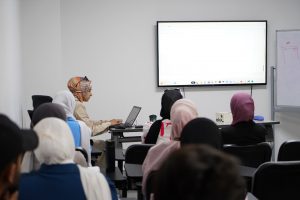
Estarta, in cooperation with the University of Jordan (UJ), launched its networking introduction course this past September.
This rigorous curriculum supplied IT students with the knowledge and abilities they need to succeed in the vast industry of networking over the course of a month.
Networking Essentials
Students began learning the basics of networking during the first part of the course. They looked at how networks affect our daily lives, analyzed network parts, and identified different network topologies. As the week ended, students were introduced to the world of IT professionals, networking protocols, protocol suites, and standards.
Navigating Number Systems
In the next phase of the networking course, students were completely immersed in the realm of number systems, which is an essential networking skill. They learned how to use the binary number system, practiced using it, and learned the mysteries of the hexadecimal system!
The Physical and Data Link Layers
As for the following chapter, students investigated the physical layer of networking and became familiar with its features. Copper cabling, UTP cabling, fiber-optic cabling, and wireless media were all examined in detail. The data connection layer has been addressed throughout this area of the syllabus, along with its function, alternative topologies, data link frame, and simulations.
Network Layer and IPv4 Addressing
The next stage of the program kicked off with a thorough examination of the properties of the network layer and the composition of IPv4 packets. Unicast, broadcast, and multicast addressing were all topics reviewed by students as they saw the realm of IPv4 addressing. Two useful skills acquired in this chapter were network segmentation and subnetting to an IPv4 network!
Transport and Application Layers
Here, students gained knowledge of data transmission methods, an introduction to TCP and UDP, and the importance of port numbers. Peer-to-peer networks, web protocols, email protocols, IP addressing services, and file sharing services are just a few of the protocols and services that were introduced to them through the application layer.
The Last Chapter: Configuration and Beyond
Practical skills were the focus of the networking course’s final week. Students gained a fundamental understanding of command structures, IOS navigation, and device configuration. They acquired practical experience creating IP addresses, configuring devices, and ensuring connectivity as well. With an emphasis on router configuration, the DHCPv4 protocol, access control lists (ACLs), and VLANs, the course came to a close.
Why It Matters
Students from UJ have benefited from this month-long adventure by gaining practical networking skills in addition to theoretical understanding. This also opened up many new doors for them as the next phases of their lives began! This networking course prepared the students for success in the fast-paced industry of information and communication technology as the need for networking specialists continues to rise.